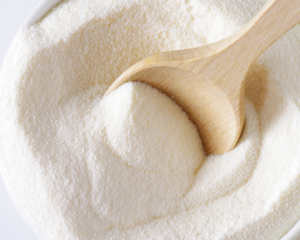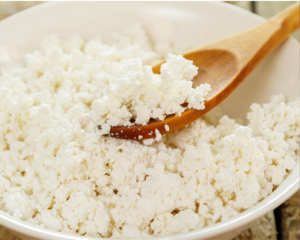Caseins
WHAT IS CASEIN?
Casein is one of the two primary components of mammalian milk. Milk consists approximately 3.6% total protein and of that 3.6%, 80% is casein protein and is 20% whey protein ( i.e. a 4:1 ratio). Casein proteins, calcium, and phosphate are aggregated together in casein micelles. Casein micelles aide the body to transport proteins and minerals. Casein is amphoteric, meaning the protein can react in the presence of an acid or in a base to form salts. Casein readily forms gels when acids or enzymes, like rennet during the cheesemaking process, are added to the protein.


WHAT IS THE DIFFERENCE BETWEEN CASEIN AND CASEINATE?
Casein is the primary protein found in milk while a caseinate is a casein product that is prepared by neutralization with a form of caustic salt such as sodium hydroxide, calcium hydroxide or potassium hydroxide. The functional properties of casein and caseinates differ widely. The casein that is isolated from coagulation by an acid or an enzyme is not native nor in its micellar form and therefore is not soluble in water or other solvents. Casein products like acid casein and rennet casein are not soluble, but caseinates are soluble in water.
WHAT IS CASEIN USED FOR?
Casein is used in a variety of food applications such as in dried pastas, extruded snack products, fried foods, coffee creamers/whiteners, and whipping powders. In addition to being a food additive, casein is also utilized in medicines, cosmetic products, in dietary supplements, as a coating for paper, in paint, and in quite a few other areas or applications.

WHAT ARE THE FUNCTIONAL PROPERTIES OF CASEIN?
Casein functional properties include fat emulsion, foaming, solubility at a pH greater than 6.0, precipitation by calcium, water binding, precipitation by chymosin, and heat stability. The functional properties of casein differ from those of whey which include gelation and solubility at a wider range of pH points.
WHAT DOES CASEIN TASTE LIKE?
Casein overall has a very bland flavor profile. Casein has been noted to taste papery, slightly sweet, and overall neutral. Towards the end of a casein products’ shelf-life, casein starts to have stronger cardboard and paper notes. The mouthfeel of a casein product is thick and foamy with a slight astringency on the tongue.


WHAT ARE THE BENEFITS OF CONSUMING CASEIN?
Casein is a complete protein source containing the NINE essential amino acids that the body cannot produce on its own. Casein also contains carbohydrates to be used as an energy source in the body as well as provide two essential elements the body needs to function: calcium and phosphorus. Casein is slowly digested by the body when consumed and can help to grow muscle and aide in recovery after exercise. Consistent casein consumption can aide in satiety and help with weight management or weight loss. Consumption of casein helps to decrease insulin responses in the body when digested before a meal and can also increase fat metabolism.
